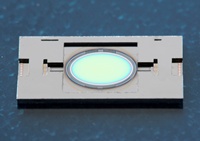Laser, instead of drill, for brain surgery developed
08 May 2013
If the brain starts to swell after a stroke, surgery is often the only treatment option – one in which the physicians open the patient's cranial vault. Up to now, they would reach for the drill and the saw. Soon, a laser beam will cut the bone and lower the risk.
 |
| The IPMS micro-mirror measures just 6 x 8 millimeters and covers a greater surface area than conventional models. The size enables it to guide large-diameter laser beams. (© Fraunhofer IPMS) |
A stroke strikes suddenly, and just as suddenly tears many of those who are stricken away from the life they are used to. If the infarction is a major one, this may cause the brain to swell.
The pressure in the cranial cavity increases, perfusion to the brain diminishes and the brain suffers further damage. To protect it from contusions, the surgeon will often open the patient's cranial vault – this is referred to as a release craniotomy. Until now, surgeons cut the cranial bones mechanically, that is, with a trephine.
However, that approach comes with a truly high risk to the patient: By using the trephine, the surgeon could inadvertently injure the meninges, which could then lead to meningitis and, in the worst case scenario, to death.
Researchers at the Fraunhofer Institute for Photonic Microsystems (IPMS) in Dresden, together with their colleagues at the Fraunhofer Institute for Laser Technology (ILT) and at Integrated Circuits IIS, intend to lower this risk by replacing the trephine with a highenergy femto-second laser.
''Our colleagues at ILT have engineered a device that allows the surgeon to guide the laser beam and cut the cranial bone,'' says Dr. Thilo Sander, group manager at IPMS.
New high-performance micro-mirror
The laser beam is fed into the hand piece through an articulated mirror arm. Its core consists of two new types of micro-mirrors that the researchers at IPMS developed.
The first makes the cranial vault incision; it directs the laser beam dynamically across the cranial bones. The second adjusts any malpositioning.
The special thing: The components are miniaturised, but can tolerate up to 20 watts of laser output – which is about two hundred times more than conventional micro-mirrors.
These can already reach their limits at 100 milliwatts, depending on their specific design. In addition, at 5 x 7 or 6 x 8 millimeters, they are very large and thus, can also guide large diameter laser beams. By comparison: Conventional micro-mirrors measure from 1 to 3 millimeters.
How did the researchers achieve this? ''Whereas the silicon panel in conventional micro-mirrors is mirrored by an aluminum layer measuring a hundred nanometers thick, we applied highly-reflective electric layers to the silicon substrate,'' explains Sander.
Therefore, in the visible spectral range, the mirror reflects not merely 90 percent of the laser beam, like typical components, but 99.9 per cent instead. Much less of the high-energy radiation penetrates into the substrate. That means the mirror ''discerns'' less of the laser beam and tolerates markedly greater power.
The challenge for the researchers primarily lay in capturing this high power coating onto the silicon substrate, just a few micrometers thin, that is commonplace in microsystems technology. Because the researchers must apply several different layers – altogether a few micrometers thick – in order to achieve the desired reflective properties.
However, a certain mechanical stress prevails in each of these layers; in addition, all layers expand at different intensities at high temperature. As a result, the substrate becomes deformed – it arches. ''This arching diminishes the optical quality of the mirror. We counterbalance this by applying this same coating on the reverse side of the substrate,'' reveals Sander.
Demonstration models of the handpiece and the micro-mirror already exist. The researchers will exhibit them at the ''Laser – World of Photonics'' convention from 13 to 16 May in Munich.
In subsequent stages of development, the scientists intend to optimise the incision performance.













.jpg)






.jpg)









